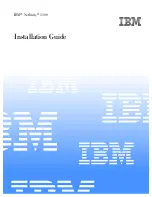
3. Remove the hot-swap lock bar:
a. Unlock the side-cover lock.
b. Rotate the hot-swap lock bar forward and remove it from the bezel. If the
hot-swap lock bar will not rotate, press the top of the hot-swap lock bar to
release the lock mechanism.
4. Remove the filler panel from one of the empty hot-swap bays by inserting your
finger into the depression at the left side of the filler panel and pulling it away
from the server.
5. Install the hard disk drive in the hot-swap bay:
a. Ensure that the tray handle is open (that is, perpendicular to the drive).
b. Align the drive assembly with the guide rails in the bay.
c. Gently push the drive assembly into the bay until the drive stops.
d. Push the tray handle to the closed (locked) position.
e. Check the hard disk drive status indicator to verify that the hard disk drive is
operating properly.
If the amber hard disk drive status LED for a drive is lit continuously, this
indicates that drive is faulty and needs to be replaced. If the green hard disk
drive activity LED is flashing, this indicates that the drive is being accessed.
Note:
If your server is configured for RAID operation using the integrated SCSI
controller with RAID capabilities or an optional ServeRAID controller, you
might need to reconfigure your disk arrays after installing hard disk
drives. See the ServeRAID documentation on the
IBM ServeRAID
Support
CD for additional information about RAID operation and
complete instructions for using ServeRAID Manager.
6. If you are installing additional hot-swap hard disk drives, do so now; otherwise,
replace the hot-swap lock bar.
7. If you have other options to install or remove, do so now; otherwise go to
“Completing the installation” on page 34.
SCSI IDs for hot-swap hard disk drives
The hot-swap-drive backplane controls the SCSI IDs for the internal hot-swap drive
bays. The SCSI ID for each hot-swap hard disk drive is printed on the hot-swap
lock bar. Table 3 lists the SCSI IDs for the hard disk drives and backplane that are
connected to one channel in hot-swap hard disk drive models. In the typical
configuration, the standard hard disk drives and backplane are connected to
channel A.
Table 3. SCSI IDs for standard hot-swap hard disk drives and backplane
Device
SCSI ID
Drive bay 9
0
Drive bay 8
1
Drive bay 7
2
Drive bay 6
3
Drive bay 5
4
Drive bay 4
5
Backplane
8
Chapter 2. Installing options
27
Summary of Contents for 8647 - Eserver xSeries 225
Page 3: ...IBM xSeries 225 Type 8647 Installation Guide ERserver...
Page 15: ...23 50 110 50 110 23 50 50 23 50 50 Safety xiii...
Page 16: ...23 50 110 50 110 50 Kg 50 23 23 50 110 50 110 xiv IBM xSeries 225 Type 8647 Installation Guide...
Page 17: ...23 50 110 50 110 23 50 50 23 50 110 50 110 Safety xv...
Page 20: ...xviii IBM xSeries 225 Type 8647 Installation Guide...
Page 70: ...Figure 7 Hints and tips feature 50 IBM xSeries 225 Type 8647 Installation Guide...
Page 72: ...52 IBM xSeries 225 Type 8647 Installation Guide...
Page 80: ...60 IBM xSeries 225 Type 8647 Installation Guide...
Page 106: ...86 IBM xSeries 225 Type 8647 Installation Guide...
Page 110: ...90 IBM xSeries 225 Type 8647 Installation Guide...
Page 111: ......
Page 112: ...Part Number 88P9294 Printed in U S A 1P P N 88P9294...
















































